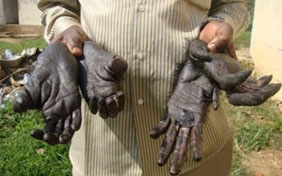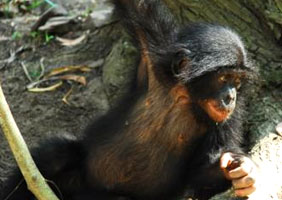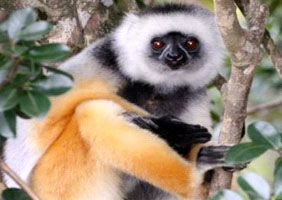|
Lesser than 250 Cross River gorillas (Gorilla gorilladiehli) exist in Cameroon and Nigeria. About 880 mountain gorillas (Gorilla beringeiberingei) remain in Uganda, Rwanda and the Democratic Republic of Congo. The number of western lowland gorillas (Gorilla gorilla gorilla) is about 95,000 based on an assumption that all intact habitats in Western Equatorial Africa contain gorillas. Endangered Species International (ESI) found recently a new population of western gorillas in the Republic of Congo threatened by illegal bushmeat trade and deforestation. ESI found 72 gorilla nests and 38 chimpanzee nests and has been conducting conservation activities to protect gorillas and rainforest.
The bonobo (Pan paniscus) is an endangered primate endemic to the Democratic Republic of Congo. Past surveys that have been conducted give a minimum population of about 15,000-20,000 individuals. In Madagascar, over 90% of lemurs(90 of the 101 species of lemur) are threatened with extinction. Threats include destruction of their tropical forest habitat, where political uncertainty and increasing poverty levels have accelerated illegal logging. Hunting of these animals for food has also emerged as a serious issue. Drills (Mandrillusleucophaeus) which are closely related to baboons have become one of the most endangered primate species in Africa, with an estimated population as low as 3,000 animals. Eighty percent of the world’s remaining drills live in Cameroon.
In Asia, the number of Sumatran orangutans (Pongoabelii) has fallen by 50% since 1992, and the entire population of the Hainan gibbon (Nomascushainanus) endemic to Hainan Island, China has only 21 individuals. This species inhabits remnant forest. It is diurnal, arboreal, and mostly frugivorous. In northern Vietnam, the critically endangered Tonkin snub-nosed monkey (Rhinopithecusavunculus) has 113 individuals left in the wild. The three slow Loris species recently discovered in Borneo are already threatened by illegal pet trade and habitat loss. Lorises, tiny nocturnal primates found in southern Asia, are increasingly at risk due to illegal wildlife trade and their use in traditional Asian medicine. Lorises are also often caught for the pet trade - despite their toxic bites, which can lead to anaphylactic shock and even death in humans. The Mentawai Islands of Indonesia are home to four endemic and threatened primates: the simakobu monkey (Simiasconcolor), Mentawailangur (Presbytispotenziani), Mentawai macaque (Macacapagensis), and Kloss’s gibbon (Hylobatesklossii). They all are dependent on the forests that are now threatened by legal and illegal logging, conversion to commercial oil palm plantations, and forest clearing and product extraction by local people.
Primates are our closest living relatives and more than 90 percent of all known primates occur in rainforest. The rapid exploitation of natural resources poses a vital threat to primates in Africa and Asia. The extraction of natural resources include timber, minerals, oil and gas, and the development of infrastructure.
Primates are increasingly becoming a major ecotourism attraction, and primate-watching is growing in interest and serving as a key source of livelihood in many local communities living around protected areas in which these species occur. Primates serve as seed dispersers and help to maintain forest diversity. ESI is actively engaged in saving primates including protecting and restoring their forests.
Links
|
|

Gorillas are illegal poached for bushmeat trade © Endangered Species International

A young bonobo © Endangered Species International

Endangered crested black macaque from Indonesia © Paddy Ryan

Threatened Lemur (propithecusdiadema)from Madagascar © Coke Smith

Endangered orangutan © Endangered Species International
|









